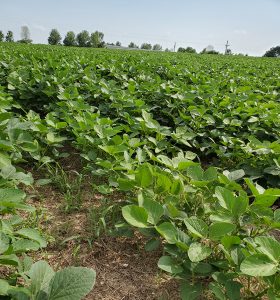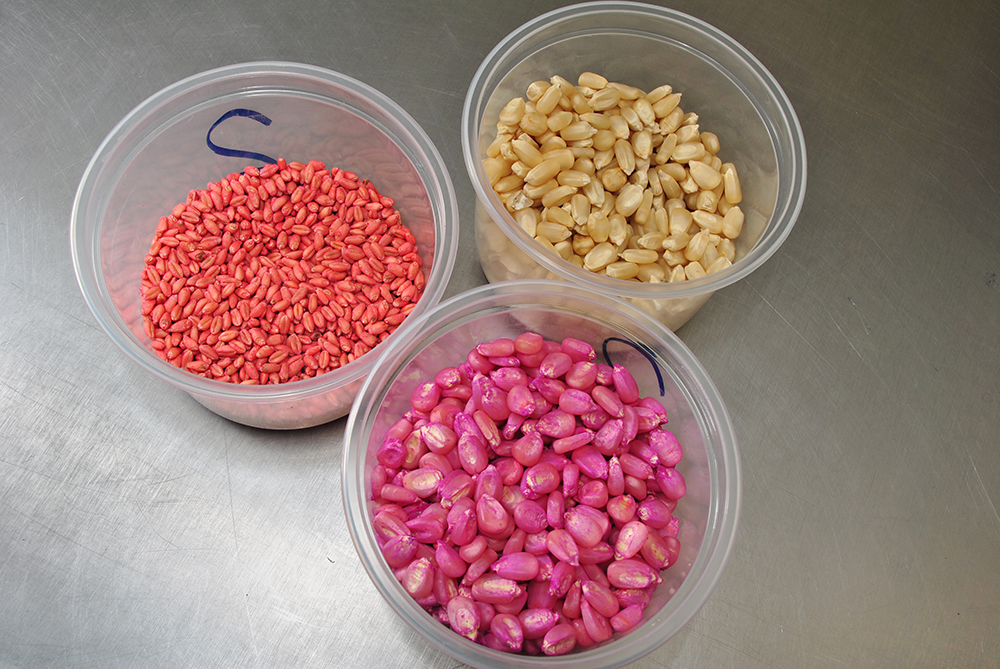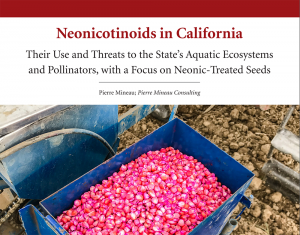It appears that scientists, and farmers too, are taking a closer look at the ubiquitous use of neonicotinoid seed treatments in US corn, soybean and other crops.
Neonics are powerful insecticides used to coat the outside of a wide variety of seeds including grain and oilseed crops. The brightly-dyed layer of pesticide is designed to dissolve in water and be taken up by the plant as it grows, providing for a few to several weeks protection from insects and nematodes.
Seed treatments include the neonicotinoids (neonics) imidacloprid, clothianidin, thiacloprid, and thiamethoxam, which are sold under trade names such as BASF’s Poncho, Bayer’s Gaucho and Syngenta’s Cruiser (Rose, 2020). And while it is true that they are less acutely toxic to vertebrates than many of the older insecticides they replaced, neonics are non-selective when it comes to insects and other invertebrates. They are especially lethal to the early life stages of insects that first hatch in the soil in the spring spring and may impact other non-target insects when residues are expressed in pollen, nectar or plant guttation fluids of the crop and surrounding field borders..
Only a small proportion of the seed treatments reaches the target crop; the rest remains in the soil where it impacts the millions of invertebrate microorganisms that make up healthy soil. Or through leaching and runoff impacts aquatic insects and crustacea a long way from the farm field. . We’ve previously covered the environmental and human health impacts of neonics a time or two on Hygeia.

There are many other types of seed treatments too, so many that every year the University of Wisconsin puts out a handy guide for farmers to help them wade through the slew of commercial seed treatment options registered for the more common field crops, most of which entail combinations of one insecticide and one to three fungicides. In the latest version, the insecticide seed treatments are color-coded purple – take a look here.
New Science on Seed Treatments
Recently scientists and farmers have started to take a critical look at whether neonic seed treatments really result in higher yields for farmers. In one literally home-grown experiment, a Midwestern farmer decided to see for himself whether seed treatments produced higher yields sufficient to cover their cost.
I. A Farmer Looks for Answers

As Jorgen Rose with Practical Farmers of Iowa reports, Dick Sloan is a corn and soybean farmer from Rowley, Iowa. Sloan is among the farmers who have grown weary of pesticide advertising and marketing pitches grounded in “fear-mongering” and what this or that pest might do to their crops.
Plus, he understood the vital importance to his bottomline of soil health and biodiversity, and knew neonics were indiscriminate killers with some nasty side effects on below-ground biodiversity. “I wanted to test whether I was addressing a real risk,” Sloan said, and so he designed and carried out a test to determine the impact of seed treatments on crop yields on his farm (Rose, 2020).
Sloan planted side-by-side plots of treated and untreated soybeans. In the first two years, he “saw no differences in yield between treated and untreated seed. In other words, the soybean treatment he had paid extra for at the dealer did not result in any increased income” (Rose, 2020). His farm didn’t have a problem with the pests these neonics targeted, so the chemicals were not making a measurable difference.
In light of these results, Dick Sloan no longer uses neonic treated soybean seeds, although he still plants treated corn seed, in part because non-treated varieties are so hard to find. His story is just one, real-world example of how farmers can take back control over a costly management decision and input purchase that reliably contributes to the profits of pesticide companies, but not farmers.
II. Analyzing Supposed Yield Benefits of Neonic-treated Soybean Seed
A group of researchers looking at 14 soybean-growing states on a much larger scale came to essentially the same conclusion. The study, published in the summer of 2019 in Scientific Reports, examined yields at 104 randomized and replicated soybean fields. They found that there are “negligible and management-specific yield benefits attributed to [neonic seed treatments {NST}].”
group of researchers looking at 14 soybean-growing states on a much larger scale came to essentially the same conclusion. The study, published in the summer of 2019 in Scientific Reports, examined yields at 104 randomized and replicated soybean fields. They found that there are “negligible and management-specific yield benefits attributed to [neonic seed treatments {NST}].”
According to the authors, “Despite widespread use, this practice appears to have little benefit for most of soybean producers; across the entire region, a partial economic analysis further showed inconsistent evidence of a break-even cost of [fungicide or neonic seed treatments]… These results demonstrate that the current widespread prophylactic use of NST in the key soybean-producing areas of the US should be re-evaluated by producers and regulators alike” (Mourtzinis et al., 2019).
III. Environmental Impacts of Neonic Seed Treatments in California
Pierre Mineau is one of the most widely known and respected scientists in the world working on the ecological impacts of pesticides. This Canadian scientist has published dozens of seminal papers, and investigated many of the most tragic episodes of pesticide-induced bird and fish kills around the world.
Since the late 1990s when neonic use started to take off, Mineau has tracked the impacts of this family of chemistry on aquatic and terrestrial foodwebs, birds, bats, and pollinators – in short, ecosystem integrity and biodiversity.
In his most recent report, Dr. Mineau explains why we should worry about the ubiquitous use of neonicotinoid seed treatments. His analysis of neonic use in California points out that since seed treatments are less rigorously regulated than pesticides sprayed on food crops, they “escape scrutiny and tracking requirements applicable to other pesticide uses” (Mineau, 2020). California is used as a test case because a wide variety of crops are grown in the State and because California has some of the best pesticide use reporting in the world.
This report provides key new insights:
- If adopted universally on all crops for which neonic seed treatments are registered, seed treatment uses of neonics in California would exceed 512,000 pounds – over 100,000 more than all other neonic applications in the state.
- Neonic seed treatments could potentially be used on over 4 million acres, roughly 76% of California’s total cropland.
As Mineau points out, this much pesticide use can’t help but have an impact.
The results of periodic water sampling in California drive his concern. Neonics are commonly found in surface waters, often at levels that exceed the USEPA benchmark concentration by 10-fold or more. In some places, like the Salinas River in Monterey County, data suggests a “very high probability that neonics are causing ecosystem-wide damage” (Mineau, 2020).
This story is all too familiar. Insect decline is widespread worldwide, and neonics are considered a major driver. This, in turn, impacts pollinators like bees, and the birds and other animals that rely on insects for food.
The ubiquitous use of neonic seed treatments is certainly not helping the birds and the bees. If it’s not helping farmers either, then maybe it’s time for a change?
Sources:
Mineau, Pierre, “Neonicotinoids in California: Their Use and Threats to the State’s Aquatic Ecosystems and Pollinators, with a Focus on Neonic-Treated Seeds,” 2020, Pierre Mineau Consulting.
Mourtzinis, S., Krupke, C. H., Esker, P. D., Varenhorst, A., Arneson, N. J., Bradley, C. A., Byrne, A. M., Chilvers, M. I., Giesler, L. J., Herbert, A., Kandel, Y. R., Kazula, M. J., Hunt, C., Lindsey, L. E., Malone, S., Mueller, D. S., Naeve, S., Nafziger, E., Reisig, D. D., Ross, W. J., Rossman, D. R., Taylor, S., & Conley, S. P.; “Neonicotinoid seed treatments of soybean provide negligible benefits to US farmers;” Scientific Reports, 2019, 9(1), 11207; DOI: 10.1038/s41598-019-47442-8.
Rose, Jorgen; “A Costly Gamble;” Practical Farmers of Iowa, Date Published: October 23, 2020, Date Accessed: October 26, 2020.
Smith, Damon and Proost, Richard; “What’s on your seed?;” University of Wisconsin-Madison College of Agricultural and Life Sciences, 2020.


